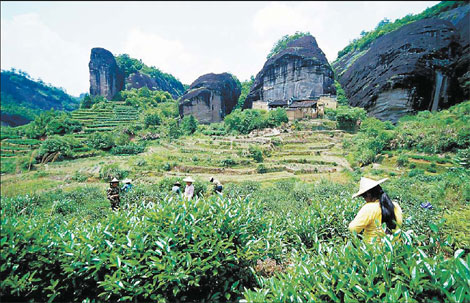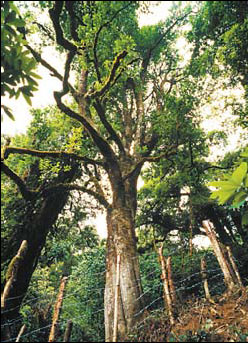Some of China's best sightseeing destinations also produce the country's best teas. So take advantage of the Chinese National Day holidays to check out the great sights and sip the teas while you're at it.
 |
|
A tea plantation on the Wuyi Mountains.
|
Autumn is the best time of year for oolong and the pick of the crop is now to be found in East China's Fujian province. Four famous Chinese oolong teas are tieguanyin (Iron Goddess of Mercy), produced in southern Fujian; dahongpao (big red robe) in northern Fujian; fenghuang (phoenix) dancong oolong in Guangdong province, and dongding (top-frozen) oolong in Taiwan.
It is the best time of year to visit the Wuyi Mountains, which produce the four most famous northern Fujian oolong teas: dahongpao, also called "rock teas" as they grow on cliffs; baijiguan (white cockscomb); Wuyi rougui (rock teas with cinnamon flavor); and Wuyi shuixian (rock teas with the scent of narcissus flowers).
Oolong tea is half fermented and looks dark green. Because they grow on the mountains, northern Fujian oolong teas are known for their floral fragrance and a "rock rhyme". They taste strong, round and have a descending power in the body, which people call "the bone of rocks". The fragrance lingers long in the mouth.
The big red robe tea got its name from a story. A Chinese scholar in the Ming Dynasty (1368-1644) was passing through Fujian when he fell sick with a stomachache.
Local monks offered him a cup of tea and cured him, so that he not only took a national qualifying exam for officials but also became the top qualifier. He also used the tea to cure the Queen's stomach problem. He later returned to Fujian and tied a red robe of honor on the tea tree.
 |
|
Wild tea trees that are more than 1,000 years old can be found in the southernmost part of Yunnan province.
|
While the dahongpao is the most famous northern Fujian oolong tea, Wuyi rougui is known for its great fragrance and Wuyi shuixian for its good taste. The rock teas are best for people who want to lose weight and get rid of that heavy feeling in the stomach.
Be warned, though - they also reduce blood sugar so fast, that you can suddenly end up with a low blood-sugar level and become weak in the limbs or even dizzy, if you drink too much on an empty stomach. If that happens, eat some candy, or some snack food.
The Wuyi Mountains have a typical danxia topography, characterized by a distinctive red sandstone land formations. It is said that the 36 peaks and 99 famous rocks all produce good oolong.
Tieguanyin, another famous oolong tea in southern Fujian, is also in its prime now. Its home region, Anxi, has a tea farming history dating back to the Tang Dynasty (618-907) and produces 15,000 tons of oolong in 16,700 acres of tea gardens. Most of the population is involved in tea cultivation.
Tieguanyin has a pure, refreshing orchid fragrance and a dark green color resembling iron. It got its name from Wei Yin, a local tea farmer in the Qing Dynasty (1644-1911), who believed that the Goddess of Mercy helped him discover this special kind of tea.